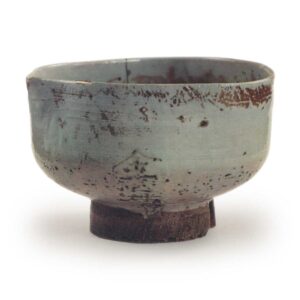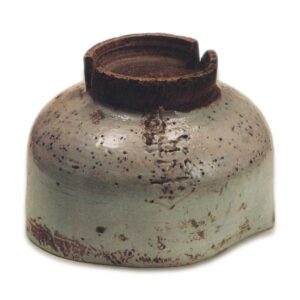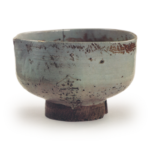

Height: 8.4-8.6cm
Diameter: 12.2-13.0cm
Outer diameter of foot ring: 6.4-6.5cm
Height of foot ring: 1.9cm
Seiobo is famous among tea ceremony practitioners as the original of the Kinkai tea bowl, and its name is based on the peach shape and the name of the tea ceremony practitioner Sosen Kuwayama.
This tea bowl is known as a “Hon-te Kin-kai” tea bowl, and it is one generation older than the oval-shaped tea bowls from the Busan kiln. It is thought to have been made at the Kin-kai kiln in the early days of the Mamehama-Wakan, or the beginning of the Edo period, although it is a “Kirigata” tea bowl in terms of its style of making. Compared to later Kinsei ware, the overall style is more robust and strong, and the foot ring and nail-carved Kinsei mark also clearly show the characteristics of the period.
The mouth of Kinsei ware is peach-shaped or suhama-shaped, and this Xi Wangmu is peach-shaped. The glaze is slightly bluish and seems to be partially vitrified, and the inside is beautifully smooth, with some areas of fire marks. The exterior has a rough texture with fine striations, and the glaze is uneven, with fine pits all over the lower half of the body, which give it a distinctive reddish glow. The gold-inlaid signature on the front is spectacular, and there is a world of difference between this and the weak, cursive signatures seen on later pieces. This is only found on the main handle. There is a fire-space below the signature, which adds to the overall effect. The foot is large, high and imposing, and it is broken in two places.
Most of the Kin-hai ware seen in the world today is the work of the Busan kilns of later generations, and the style is light and superficial, with a shallow impression, but this kind of hand-made tea bowl, which is so strong in style and truly expresses the mood of the times, is extremely rare. Also, the so-called Kan-kai characteristic of the “neko-kaki” (cat scratch) pattern of the hinoki-gaki style is not present in this hon-te, and instead the “himma” (fire space) is the characteristic feature. Accessories
Inner box: paulownia wood, plain, with “Kan-kai Sai-ou-bo” written on the lid
Same as above, with “Roka Hyouin” written on the lid
Outer box: paulownia wood, gold powder characters “Queen Mother of the West” on the front of the lid, written by Yagura Chikuo
Same as above, paper with Hirose Roka’s seal on the back of the lid
This tea caddy was passed down through the Yagura Chikuo family in Kyoto, and is considered one of the ten Yagura tea caddies. It later entered the Hirose family, and when the Hirose family sold it, it returned to the current owner’s collection.








